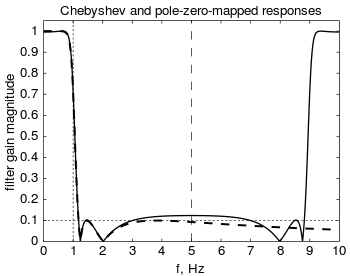

匹配Z变换方法(matched Z-transform method)也稱為極點-零點映射(pole–zero mapping)[1][2]或極點-零點匹配法(pole–zero matching method)[3],簡稱MPZ或MZT[4],是將連續時間濾波器轉換到離散時間濾波器(数字滤波器)設計的技巧。
其作法是將所有的s平面設計時的極點和零點轉換到z平面的位置,其中取樣週期[5]。因此以下傳遞函數的類比濾波器:
會轉換為以下的數位傳遞函數
其增益需調整,使結果為其理想的增益,一般會和類比濾波器的直流增益匹配,透過設定及,並且求解.[3][6]。
因為此映射會將s平面的軸反覆的映射到z平面的單位圓上,若零點或是極點超過奈奎斯特頻率,其映射後的位置會有混疊的情形[7]。
一般情形下,類比濾波器的極點會比零點多,在處的零點可以移到奈奎斯特頻率,作法是放在的位置[1][3][6][7]。
此轉換方式可以保持有界輸入有界輸出穩定性以及最小相位,但不會保持時域或是頻域的響應,因此不常使用[8][7]。較常使用的方式有雙線性轉換及冲激不变法[4]。匹配Z变换方法的高頻響應誤差比雙線性轉換要小,因此比較容易透過加入額外的零點來修正其特性,此方式稱為MZTi(i表示改良版improved)[9]。
在數位控制中,匹配Z变换方法有一個特別的應用,就是艾克曼公式,可以調整可控制性系統的極點,一般會將不穩定(或接近不穩定)的極點調整到穩定的位置。

參考資料
[编辑]- ^ 1.0 1.1 Won Young Yang. Signals and Systems with MATLAB. Springer. 2009: 292 [2018-10-19]. ISBN 978-3-540-92953-6. (原始内容存档于2017-09-20).
- ^ Bong Wie. Space vehicle dynamics and control. AIAA. 1998: 151 [2018-10-19]. ISBN 978-1-56347-261-9. (原始内容存档于2015-03-26).
- ^ 3.0 3.1 3.2 Arthur G. O. Mutambara. Design and analysis of control systems. CRC Press. 1999: 652 [2018-10-19]. ISBN 978-0-8493-1898-6. (原始内容存档于2019-07-30).
- ^ 4.0 4.1 Al-Alaoui, M. A. Novel Approach to Analog-to-Digital Transforms. IEEE Transactions on Circuits and Systems I: Regular Papers. February 2007, 54 (2): 338–350 [2018-10-19]. ISSN 1549-8328. doi:10.1109/tcsi.2006.885982. (原始内容存档于2018-06-04).
- ^ S. V. Narasimhan and S. Veena. Signal processing: principles and implementation. Alpha Science Int'l Ltd. 2005: 260 [2018-10-19]. ISBN 978-1-84265-199-5. (原始内容存档于2019-07-28).
- ^ 6.0 6.1 Franklin, Gene F. Feedback control of dynamic systems. Powell, J. David, Emami-Naeini, Abbas Seventh. Boston: Pearson. 2015: 607–611 [2018-10-19]. ISBN 0133496597. OCLC 869825370. (原始内容存档于2024-02-14).
Because physical systems often have more poles than zeros, it is useful to arbitrarily add zeros at z = -1.
- ^ 7.0 7.1 7.2 Rabiner, Lawrence R; Gold, Bernard. Theory and application of digital signal processing. Englewood Cliffs, New Jersey: Prentice-Hall. 1975: 224–226. ISBN 0139141014 (英语).
The expediency of artificially adding zeros at z = —1 to the digital system has been suggested ... but this ad hoc technique is at best only a stopgap measure. ... In general, use of impulse invariant or bilinear transformation is to be preferred over the matched z transformation.
- ^ Jackson, Leland B. Digital Filters and Signal Processing. Springer Science & Business Media. 1996: 262. ISBN 9780792395591 (英语).
although perfectly usable filters can be designed in this way, no special time- or frequency-domain properties are preserved by this transformation, and it is not widely used.
- ^ Ojas, Chauhan; David, Gunness. Optimizing the Magnitude Response of Matched Z-Transform Filters ("MZTi") for Loudspeaker Equalization. Audio Engineering Society. 2007-09-01 [2018-10-19]. (原始内容存档于2019-07-27) (英语).


















